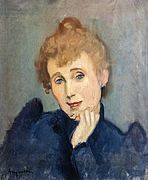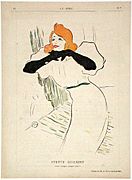Yvette Guilbert facts for kids
Quick facts for kids
Yvette Guilbert
|
|
|---|---|

Yvette Guilbert in 1913
|
|
| Born |
Emma Laure Esther Guilbert
20 January 1865 |
| Died | 3 February 1944 (aged 79) |
| Resting place | Père Lachaise Cemetery |
| Occupation | Cabaret singer, actress on stage and in silent films |
| Known for | Belle Époque diseuse, innovator of the French chanson, subject of portraits by Henri de Toulouse-Lautrec |
| Spouse(s) |
Max Schiller
(m. 1897) |
| Awards | Awarded the Legion of Honor as the Ambassadress of French Song, 9 July 1932 |
| Signature | |
 |
|
Yvette Guilbert (born Emma Laure Esther Guilbert, on January 20, 1865 – February 3, 1944) was a famous French cabaret singer and actress. She was a big star during the Belle Époque, a time in French history known for its beautiful art and culture.
Contents
Yvette's Early Life and Career
Yvette Guilbert was born in Paris, France, into a family that didn't have much money. She started singing when she was a child. At 16, she worked as a model in a large department store called Printemps in Paris.
A journalist discovered her talent. She then took lessons to learn acting and how to speak clearly on stage. In 1886, she began performing in smaller theaters. Yvette made her big debut at the Varieté Theatre in 1888.
Becoming a Star
Yvette soon sang at popular clubs like the Eldorado and the Jardin de Paris. By 1890, she was the main performer at the famous Moulin Rouge in Montmartre. An English painter named William Rothenstein saw her perform. He said she looked innocent but sang very bold songs. The audience was surprised but loved her unique style.
For her performances, Yvette often wore bright yellow clothes and long gloves. She stood very still and used her long arms to make gestures as she sang. She was known for her "patter songs," which were like spoken monologues set to music. People called her a "diseuse," which means a "sayer" or storyteller through song.
Her songs often told stories about sad events, lost love, and the struggles of poor people in Paris. Some of the lyrics were even written by her! Yvette changed the rules of music-hall performances with her brave and honest songs. Audiences in France, England, and the United States loved her.
Yvette and Famous Artists
Yvette Guilbert was a favorite subject for the artist Henri de Toulouse-Lautrec. He drew many pictures and funny drawings of her. He even dedicated one of his sketchbooks to her.
Famous people like Sigmund Freud, a well-known doctor, and George Bernard Shaw, a famous writer, also enjoyed her shows. Freud even called her his favorite singer.
Later Life and Achievements
In 1897, Yvette married Max Schiller, who helped manage her shows. She had very successful tours in England, Germany, and the United States. She even performed at Carnegie Hall in New York City.
Even when she was in her fifties, Yvette was still a big name. She acted in several silent films, including a main role in F. W. Murnau's Faust. She also appeared in movies with sound, working with her friend Sacha Guitry. She made recordings of her songs, including the famous "Le Fiacre" and some of her own songs like "Madame Arthur". Sometimes, she even played the piano for her own songs.
Yvette Guilbert performed for important people, including the Prince of Wales (who later became King Edward VII). Many hosts wanted her to perform at their parties.
Writing and Teaching
In her later years, Yvette started writing about the Belle Époque period. She published two novels in 1902. In the 1920s, she wrote a book called L'art de chanter une chanson (The art of singing a Song). This book taught others how to sing.
She also opened schools for young girls in New York and Paris. Some of her students became famous in their own right.
Yvette became an expert on French medieval folklore (old stories and traditions). On July 9, 1932, she received the Legion of Honor. This is a very important award in France. She was honored as "the Ambassadress of French Song."
Yvette Guilbert passed away in Aix-en-Provence in 1944, at the age of 79. She was buried in the Père Lachaise Cemetery in Paris.
Filmography
- Let's Make a Dream (1936) as Une invitée
- Iceland Fisherman (1934) as La Grand-Mère Moan
- The Two Orphans (1933) as La Frochard
- La Dame D'en Face (1932)
- Laissez faire le temps (1932)
- En zinc sec (1931)
- Bluff (1929)
- Le manque de mémoire (1929)
- L'Argent (1928) La Méchain
- Die lachende Grille (1926) as Die alte Fadette
- Faust (1926) as Marthe Schwerdtlein: Gretchens Tante / Marguerite's Aunt
- Los dos pilletes (1924) as Zéphyrine
- An Honorable Cad (1919)
Images for kids
Gallery
-
Jules Chéret, Yvette Guilbert, 1891 Art Nouveau poster for the famous Parisian chanteuse
-
Toulouse-Lautrec, Yvette Guilbert
-
Yvette Guilbert 1893
by Louis Anquetin -
Yvette Guilbert, 1894
by Toulouse-Lautrec
See also
 In Spanish: Yvette Guilbert para niños
In Spanish: Yvette Guilbert para niños
- Marguerite Deval








